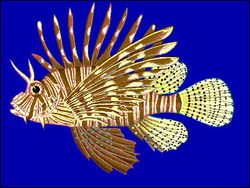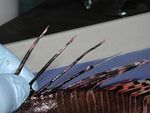| Red lionfish |
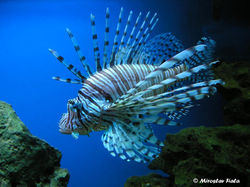 |
| Scientific Classification |
|
|
| Binomial Name |
Pterois volitans |
|
|
| A drawing of a Red lionfish |
The Red lionfish is a species of lionfish known by the scientific name Pterois volitans. It is also known as the red firefish and the turkeyfish. They are best known for their poisonous spines and predatory behavior from which they get their name. [2] Their spine are venomous, and contains a neuromuscular toxin. A sting can cause pain, sweating, respiratory distress, paralysis, and a chance of death.[3]
The red lionfish is most famous for its invasive behavior. The red lionfish originally came from the Indo-Pacific region but it is invading the Gulf of Mexico and the Caribbean Sea. Its natural habitat are coral reefs in warm, tropical waters.[4]
Body Design
The red lionfish has brown and white stripes, can grow up to 18 inches long and has fleshy tentacles above the eyes and under the mouth. But their most striking feature are their 13 poisonous dorsal spines and pectoral rays.[4] It has 10-11 dorsal soft rays and 6-7 soft anal rays. It also has cycloid scales which means that the anterior (toward the front) end is overlapped by the posterior (toward the rear) end giving the fish more flexibility.[3]
One of the most interesting parts of the red lionfish is its poisonous spines. The venom is not usually lethal for humans but a sting is extremely painful. The venom from the red lionfish is a neuromuscular toxin (affecting the nerves and muscles) and a neurotransmitter (a substance that transmits nerve impulses across a synapse) acetylcholine.[5]The red lionfish uses its spines for hunting. They can trap their prey, paralyze it, and then they can eat it. They do not always have to do this however. The red lionfish also uses their spines for protection, and because of this the areas that they are invading have no natural predators.[6]
Life Cycle
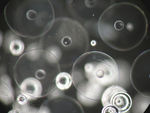
A picture of Red Lionfish eggs
The red lionfish (Pterois volitans) learns how to hunt at an early age. After they are born they begin to hunt small ciliates while only four days old. The larvae moves out of the water column after a period of approximately 25 to 40 days, at a size of 10-12 mm in length. [7] The Pterois volitans reproduction is sexual and utilizes external fertilization. [8]
Red lionfish are quick to bulk up and they develop large body sizes at an early age. This makes the predators stay away from the red lionfish so as to preserve the animals life. Also when they bulk up and develop their large body size it makes them more successful in mating. [9]
Ecology

the places where the
Pterois volitans originated
The red lionfish originated from the Indo-Pacific. Which starts from southern Japan to Micronesia, Australia, and the Philippines. When they are young they usually stay in groups, but when they are adults they will they travel alone.[10] It is said that the red lionfish loves to stay around coral reefs, but it still can be found in coral patches, sandy bottoms,and canal habitats. The red lionfish occurs around temperatures of 71.6 °F to 82.4 °F and can be found in depths of 32.8-574.1. [11]
The red lionfish usually eats any small fish, crabs, or shrimp. The red lionfish also has a unique way devouring their prey; they devour them in one gulp by spreading their pectoral fins and surrounding their prey.[12] The red lionfish usually eats at least 8.2 grams times its body weight per year. They also hunt for their food at night. The red lionfish shields his caudal fins by using its pectoral rays. This makes the prey unaware of the red lionfish, and soon when the prey is unaware the red lionfish attacks its prey. [13]
Invasive Behavior
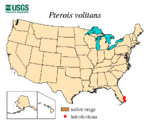
A map showing the Red lionfish's invasive range.
The red lionfish is invasive to the Gulf of Mexico and the Caribbean Sea.[4]It was discovered near Dania Beach in Florida 1985.[14] They were introduced there when aquarium tanks broke open after Hurricane Andrew hit Florida.[4]
The red lionfish is very poisonous and is on the top of the food chain in most ecosystems. It is on the top of the ecosystem because of its poisonous spines. They also reproduce in mass quantities. In ecosystems that they are invading, this has a negative effect. This is negative because there are a lot of lionfish but none of them are being eaten or removed naturally. Another dangerous feature of the red lionfish is that they can eat their prey whole, giving them no chance for survival.[4]
Control Efforts

This is a red lionfish reporting sticker. If you see a lionfish call this number
The red lionfish is being controlled in several ways. One way the red lionfish is being controlled is by hunting them for recreation and for food. Their are many organizations that will hunt them to remove the red lionfish from their oceans.[15] Many researchers think that the red lionfish invasion can't be undone. They plan on controlling it by using predators to eat either the red lionfish, their egg, or larvae.[16]The government of Florida is encouraging people to hunt the red lionfish. People can hunt it by spear fishing or by casting nets into the water. There is currently no bag limit on the red lionfish because the government wants to get rid of it from their waters.[14]
Many experts think that complete eradication of the red lionfish is impossible. Instead they are just trying to control the population. Organizations like the Reef Environmental Education Foundation(REEF) and the Bahamas Reef Environmental Educational Foundation(BREEF) are encouraging people to remove the red lionfish from their waters. They are sending volunteers out to stop the spread of the red lionfish and they are also encouraging people to eat them. However places where the red lionfish is being constantly consumed there are no noticeable changes in their population numbers.[16]
Video
Two videos about the red lion fish and how they are invasive.
References
- ↑ Pterois volitans Wikispecies. Web. last update on December 23 2013 at 10:53. Unknown author.
- ↑ Robins, Robert. Red Lionfish FLMNH. Web. Accessed on October 23rd, 2014.
- ↑ 3.0 3.1 Lionfish Biology Fact Sheet Lionfish Biology Fact Sheet. Web. Last modified. May 31, 2011. Author Unknown
- ↑ 4.0 4.1 4.2 4.3 4.4 Wood, Mahya. Red firefish University of Michigan Museum of Zoology. Web. Created in 2001.
- ↑ The Lionfish Invasion! NOAA . Web. last-update May 09, 2011 Unknown Author .
- ↑ Flatheads Gurnards Scorpionfishes and Relatives: Scorpaeniformes - Red Lionfish (pterois Volitans): Species Accounts jrank . Web. Accessed on October 19, 2014 Unknown Author .
- ↑ NA. Diving with Lionfish Dive the World'for mating '. Web. 8 October 2014. (Date-Accessed).
- ↑ J. Masteron. Red Lionfish Smithsonian Station at Fort Pierce. Web. December 1, 2007. (Date-Updated)
- ↑ NA. Diving with Lionfish Dive the World'for mating '. Web. 19 October 2014. (Date-Accessed).
- ↑ Schofield. PJ. Morris, JA. Langston, JN. Fuller, Pl. [1] Nonindigenous Aquatic Species. Web. Last modified September 18, 2012.
- ↑ [2] Global Invasive Species Database. Web. Last modified. August 10, 2010. Author Unknown
- ↑ [3] Smithsonian Marine Station at Fort Pierce. Web. Last modified. December 1, 2007. Author Unknown
- ↑ Fishelson, L. [4] Animal Diveristy Web. Web. date accessed October 27, 2014.
- ↑ 14.0 14.1 Lionfish FWC. Web. Accessed on October 27th, 2014. Author unknown
- ↑ lionfish hunting Lionfish Hunters. Web. Visited on October 14 2014. Unknown author.
- ↑ 16.0 16.1 Morris Jr., J.A. and Akins J. L. . Noaa's Coral Information System NOAA. Web. Last Update November 14, 2008.

